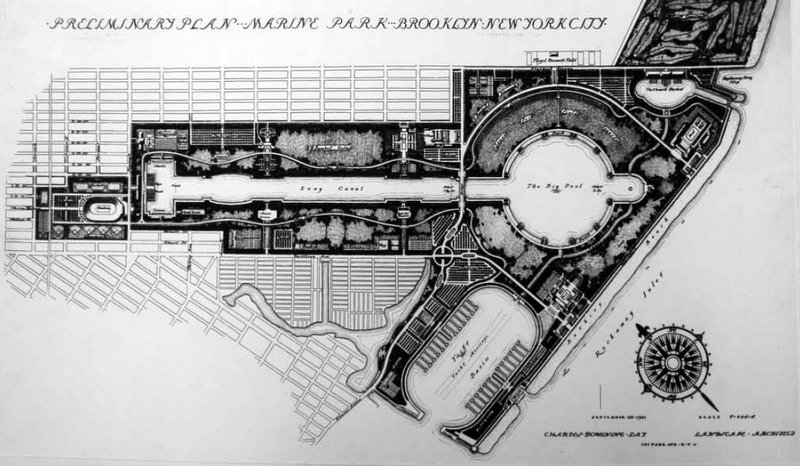6. An Olympic Silver Medal Was Awarded for an Architectural Plan for Marine Park
 Charles Downing Lay, preliminary plan for Marine Park, Brooklyn, September 1931 (Carl A. Kroch Library, Cornell University)
Charles Downing Lay, preliminary plan for Marine Park, Brooklyn, September 1931 (Carl A. Kroch Library, Cornell University)
In the same bay as Mau Mau Island, you can see wood pilings that were part of a grand park and athletic facility planned for Marine Park. The never-realized design by Charles Downing Lay even won the silver medal at the 1939 Olympics in Berlin when the event had a town planning competition. Lay hoped that the park would be “a park for the people of Brooklyn and all New York that shall be as beautiful as any private estate and finer than any park of its kind ever built.” As Thomas J. Campenella notes in the article, “Playground of the Century: A Political and Design History of New York City’s Greatest Unbuilt Park,” the failure to build this park ironically led to the preservation of the natural tidal landscape in Marine Park.
The park would have been more than 1,800 acres in size, larger than both Central Park and Prospect Park combined, writes Campenella, and that
“It would feature bowling greens, archery butts, bocce pitches, picnic groves, lacrosse and croquet fields, 200 tennis courts, eighty baseball diamonds, and three outdoor swimming and wading pools. There would be a skating rink, a zoo, an eighteen-hole golf course, thirty restaurants and cafeterias, a 1,000-seat casino with formal gardens, and an open-air theater and a music grove that, together, could accommodate 30,000 patrons. Regional access would be handled by a Marine Park stop on the proposed Utica Avenue elevated line. Circulation within the vast site would be facilitated by thirty miles of walkways and nine miles of road served by circulator buses”
In the style of the City Beautiful, much of the landscape would be significantly reshaped with artificial canals, large pools where yachts, racing boats, and pleasure boats would maneuver, and boat basins. There were also plans to build the largest football stadium in America, which would fit 125,000 people, along with impressive bathing pavilions that could host 12,000 people at a time. Lay also hoped that this park would also be an entertainment destination to rival Coney Island.
The grand plan was waylaid by corruption charges within Mayor James Walker’s administration and the plan and ongoing construction at Marine Park became a symbol of the waste, an easy target for new mayor Fiorello LaGuardia, in his quest to clean up New York City and Robert Moses, newly appointed as commissioner of the Parks Department. 5,400 workers were assigned to the Marine Park plan and were said to be mostly lounging around. In addition, Lay was not in a good position with Moses, having repeatedly opposed the master builder’s efforts on Long Island. Moses even had a nickname for him: “Landscaper Lay.”





